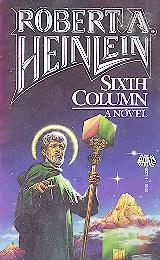Sixth Column
|
|
Sixth Column, also published under the title The Day After Tomorrow, is a science fiction novel by Robert Heinlein, set in a United States that has been conquered by a foreign invader. Originally published as a serial in 1941, it was collected as a novel in 1949. It centers on the activities of a research lab hidden in the Colorado mountains, which is the last remaining outpost of the United States Army after its defeat by the PanAsians. The PanAsians are a combination of the Chinese and Japanese. The conquerors had absorbed the Soviets after an attack by them and had gone on to amalgamate India as well. The invaders are depicted as ruthless and cruel - for example, they crush an abortive rebellion by killing 150,000 American civilians as punishment.
The book is notable for its frank and controversial portrayal of racism. The Pan-Asian conquerors regard themselves as a chosen people predestined to rule over lesser races, and they refer to white people as slaves. "Three things only do slaves require: work, food, and their religion." They require outward signs of respect, such as jumping promptly into the gutter when a member of the chosen race walks by, and the slightest hesitation to show the prescribed courtesies earns a swagger stick across the face. One character is Frank Mitsui, an Asian-American man whose family was murdered by the invaders because they did not fit in the new PanAsiatic racial order. The Americans in the novel respond to their conquerors's racism by often referring to them in unflattering terms, such as "flat face", "slanty" (a derisive reference to the epicanthal folds typical of Asian genetics), and "monkey boy".
Sixth Column and Farnham's Freehold, another novel by Heinlein, both center on the issue of race. Whereas some people perceive Sixth Column as racist, Farnham's Freehold turns the tables by reversing the racial stereotypes. The original idea for the story of Sixth Column was proposed by John W. Campbell, not by Heinlein himself, and Heinlein later wrote that he had "had to reslant it to remove racist aspects of the original story line" and that he did not "consider it to be an artistic success."Template:Ref It was written in the same year as the attack on Pearl Harbor. A more complete discussion of race in Heinlein's fiction is given in the main article on Heinlein.
Plot summary
The mountain lab is a scene of turmoil as the novel begins. All but 6 personnel died suddenly, due to mysterious forces in the magneto-gravitic or electro-gravitic spectra. The scientists at the lab soon learn that they can selectively kill people, by releasing the internal pressure of their cell membranes. They discover other awesome forces, yet their challenge is: how can a handful of men throw off an invasion force, when all their communications have been severed and it is a crime to print a word in English? Noting that the invaders have allowed the free practice of religion, the Americans set up a false church of the Lord Mota in order to build up a resistance which Major Ardmore, the protagonist of the book, refers to as as the Sixth Column.
Notes
- Template:Note Robert A. Heinlein, Expanded Universe, foreword to Solution Unsatisfactory, p. 93 of Ace paperback edition.
Editions
- February 1, 1983, New Amer Library, paperback, ISBN 0451121392 (This edition was published under the title The Day After Tomorrow. All the other editions listed were entitled The Sixth Column)
- January 2, 1988, Baen, paperback, ISBN 0671653741
- May 1, 1990, Baen, paperback, 256 pages, ISBN 0671720260
- March 1993, Baen Books, paperback, ISBN 5555716141
- July 1, 1996, Simon & Schuster (Trade Division), paperback, ISBN 0671851055
- August 1, 1999, Baen, paperback, 256 pages, ISBN 067157826Xfr:Sixième colonne

